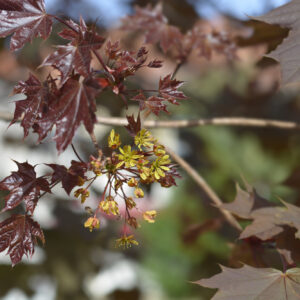Amelanchier lamarkii
Price range: £180.00 through £1,150.00
Frequently Bought Together




Description
Quick Facts
- Common Name: Snowy Mespilus, Juneberry, Serviceberry
- Botanical Name: Amelanchier lamarckii
- Plant Type: Deciduous tree/large shrub
- Mature Height: 6-10m
- Mature Spread: 6-8m
- Flowering Period: April
- Flower Colour: Pure white star-shaped flowers
- Foliage: Bronze emerging leaves turning green, then brilliant orange-red in autumn
- Hardiness: RHS H7 (very hardy)
- Soil Requirements: Moist, well-drained, slightly acidic to neutral
- Aspect: Full sun to partial shade
- Maintenance: Low
Description
Experience the enchanting beauty of Amelanchier lamarckii, one of the most beloved multi-season trees for British gardens, bringing exceptional year-round interest with its spectacular spring blossoms, edible summer berries, and one of the most reliable and brilliant autumn colour displays of any small tree. This outstanding ornamental offers four distinct seasons of beauty—clouds of delicate white flowers against bronze foliage in spring, sweet purple-black berries in summer, fiery autumn foliage in shades of orange, red, and burgundy, and elegant multi-stemmed structure with smooth grey bark in winter.
In mid-spring, this captivating tree becomes adorned with abundant racemes of pure white star-shaped flowers that cascade along the branches, creating a spectacular snowy display that gives this tree its common name. The flowers emerge alongside bronze-tinted young leaves, creating a stunning colour combination that intensifies the delicate beauty of the blossoms. As spring progresses, small green berries develop, ripening to purple-black by early summer—these sweet, edible fruits are beloved by birds and can be used for jams and pies. The foliage matures to fresh green throughout summer before transforming into one of the most spectacular autumn displays—brilliant shades of orange, scarlet, and burgundy-red that glow like flames for several weeks.
Native to North America but naturalized in Europe, this remarkable species has become a garden favourite for its exceptional reliability and adaptability. Perfectly suited to British conditions, Amelanchier lamarckii thrives in our temperate climate, tolerating a wide range of situations from full sun to partial shade, and handling both urban pollution and exposed sites with ease. The naturally graceful multi-stemmed habit requires no pruning to maintain its elegant form.
Create stunning compositions by planting as specimen trees in lawns where all four seasons of interest can be fully appreciated. Magnificent in woodland gardens where the spring flowers and autumn colour shine against darker evergreens, in mixed borders as focal points, or in groups for naturalistic plantings. Works beautifully underplanted with spring bulbs—daffodils and bluebells—that bloom alongside the white flowers, or combined with heathers, ferns, and rhododendrons that enjoy similar acidic soil conditions.
Caragh Garden Notebook
Planting: Space trees 6-8m apart for groupings, or allow 8-10m for specimen planting. Plant bare-root trees from November to March, or container-grown specimens year-round (autumn or early spring is ideal). Dig holes twice the width of the root ball and incorporate ericaceous compost or well-rotted leaf mould. Plant at the same depth as the nursery soil mark. Stake multi-stemmed specimens loosely for the first 2 years. Water thoroughly and mulch with acidic organic matter.
Soil Preparation: Thrives in moist, well-drained soil with pH 5.5-6.5 (slightly acidic to neutral). Prefers moisture-retentive conditions enriched with organic matter. Tolerates heavier clay soils if drainage is adequate. Avoid very alkaline or chalky soils which can cause chlorosis. Incorporate ericaceous compost, well-rotted leaf mould, or composted bark to improve soil structure and maintain acidity. Mulch annually with acidic organic matter.
Container Growing: Suitable for large containers (minimum 60-80cm diameter) for several years using ericaceous compost. Water regularly with rainwater where possible to maintain acidity. Feed in spring with slow-release ericaceous fertiliser. Eventually benefits from planting out for long-term health and to achieve full ornamental potential, spectacular autumn colour, and abundant fruiting.
Seasonal Care: Requires minimal pruning—the naturally graceful multi-stemmed habit develops without intervention. Simply remove any dead, damaged, or crossing stems in late winter if needed. Can be thinned to maintain open structure by removing oldest stems at ground level every few years. Apply slow-release ericaceous fertiliser in early spring. Mulch annually with acidic organic matter to retain moisture and maintain soil pH. Water during prolonged dry spells, especially when establishing and during fruit development.
Propagation: Propagate from seed collected from ripe berries in summer—clean, stratify for 3 months, and sow in spring. Germination can be slow. Suckers can be carefully separated from parent plants in autumn. Semi-hardwood cuttings taken in summer can root but success is variable. Layering is reliable—peg down low branches in autumn and separate once rooted. Most gardeners prefer to purchase nursery-grown specimens for guaranteed quality and faster results.
This multi-talented beauty is an absolute garden treasure—spring flowers, summer berries, autumn flames, and winter structure all in one graceful package! One of the most reliable trees for spectacular autumn colour your garden, plus those clouds of white spring blossoms are simply magical. A true four-season performer that earns its place in any garden!





